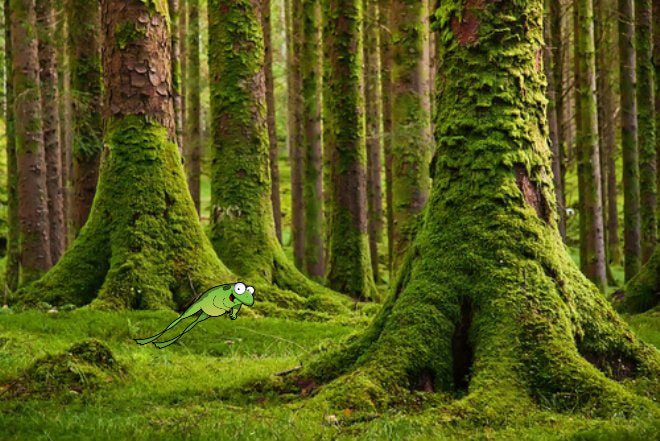Mosses are most likely the first plants to emerge from the sea and conquer the land. It has been called the amphibian of vegetation. After reading that, you know I had to look up and find out MORE about this bountiful plant. Moss has 22,00 different species whose range of size "parallels the height disparity between a blueberry bush and a redwood; they inhabit nearly every ecosystem on earth and grow in places as diverse as the branch of an oak and the back of a beetle." This is what Wikipedia has to say about it. "Mosses are small flowerless plants that typically grow in dense green clumps or mats, often in damp or shady locations. The individual plants are usually composed of simple leaves that are generally only one cell thick, attached to a stem that may be branched or unbranched and has only a limited role in conducting water and nutrients. Although some species have conducting tissues, these are generally poorly developed and structurally different from similar tissue found in vascular plants. Mosses do not have seeds and after fertilization develops sporophytes with unbranched stalks topped with single capsules containing spores." That's quite a long definition! But I include it because while simple on the surface, mosses are fairly complex little plants.
I wanted to learn more about what mosses are beyond their scientific description so I did a little research and found these fascinating tidbits of facts about moss.
1. Mosses were probably the first land plant. Descended from freshwater green algae, these moss-like organisms had an outer biopolymer that protected them from temperature changes and constant UV radiation, allowing them to withstand the unique stresses of terrestrial life. They first appeared about 500 million years ago!
2. Mosses might have triggered the Ice Age. You wouldn’t think that a small-leafed, rootless plant could wreak much havoc, but "that’s exactly what bryophytes did when they first came on the scene almost half a billion years ago. When these plants started to cover the land, they altered the bedrock’s composition, causing the earth to ‘suck’ carbon dioxide from the air. Insufficiency of the greenhouse gas cooled the planet and led to the Ordovician-Silurian Extinction Event - the second largest in earth's history."
3. Moss leaves are only one cell thick.
4. Mosses can extract water from the air.
5. Moss was used to heal wounds during World War I. dating back at least a thousand years, ancient cultures used moss to cleanse and heal their wounds. When Allied surgeons ran out of cotton on the battlefield they turned to moss as a potential stopgap. Since peat moss has high absorbency and antiseptic properties, Europe and America produced millions of moss bandages to treat their wounded over the course of the war.
6. Moss can measure air pollution. Because mosses get their nutrients from the air, they also get whatever else happens to be present. "Based on the findings from recent studies, researchers are now looking at moss’s ability to measure the presence of 22 other airborne heavy metals and compounds."
7. Before diapers, there was moss. Moss is very absorbent. Enough said there.
8. Moss is art. "As climate change produces greater negative effects on the earth, everyone is having to become more environmentally conscious...including Taggers. Known as guerrilla gardening or eco-graffiti, homemade moss solution is being used by some as an alternative to spray paint and billposting. Free of toxic chemicals and creating biodegradable works that can easily be washed off or, in some cases, even grow on walls, Bryophyta could be the next evolution of street art."
9. Moss has achieved Rock Star status in Japan. In the West, where gardens are usually manicured and precise, moss is thought to be a big detractor. Not so in Japan. "Used for both its beauty and versatility, moss is left free to grow on stones, walkways, benches, statues, and most any other garden surface. More recently, moss-themed drinks, jewelry, and tours have become all the rage in Japan, cementing the plant’s place as both a traditional and contemporary icon in Japanese culture."
10. Moss could save the planet. "Peat bogs hold approximately 455 gigatons of carbon dioxide worldwide. But with many bogs’ natural protective layer of moss damaged by pollution, dangerous CO2 is increasingly being emitted into the atmosphere. Chris Freeman, a professor at Bangor University in the UK, is hoping he can reverse this trend with a new kind of moss. Freeman’s genetically modified Sphagnum would have specific attributes that allow it to slow the decomposition of carbon-emitting peat and help stave off dangerous greenhouse gas emissions from entering the atmosphere. Unfortunately, the bioengineered moss is expected to take a decade to create, meaning that the restoration of the planet’s atmosphere won’t be coming anytime soon. " That being said, it's good that there might be some help and hope in the not too distant future.
I hope you've enjoyed this look at moss. Who knew it was so interesting...and useful!
This does it for me this week. have a super-duper weekend and please hop back by on Monday. Until we meet again, I wish you
PEACE.
https://www.ranker.com/list/amazing-moss-facts/bruce-maisy

 RSS Feed
RSS Feed